The cookware allows to concoct good dishes. These are utensils grouped together in a single set, the ultimate being those compatible with induction. But it's hard to choose between pots, pans and stewpots of different sizes. Aluminum, ceramic or stainless steel? Our guide to the best induction cookware will help you.
Here is our commitment, to make sure that we provide the best user experience and content quality:
You can support us by using our links to make your purchases (at no extra cost to you)! This sometimes earns us a commission which allows us to remain independent. More about us
Our selection
"Composed of 15 pieces, the Tefal Ingenio Preference L9409602 is a cookware with an excellent quality/price ratio. You will discover in the set uncoated pans,…"
"For less than 70 €, it is quite possible to get a quality cookware. This is the case with the Amazon Basics 1116O2OD861. With 6…"
"The ProCook Professional Steel is perfect for heavy use. The set includes 10 pieces, including pots, pans and pans. Their design with 18/10 stainless steel…"
"The Stoneline 6588 is made of cast aluminum, giving it the ability to last for years. There is no risk of scratching the bottom of…"

Composed of 15 pieces, the Tefal Ingenio Preference L9409602 is a cookware with an excellent quality/price ratio. You will discover in the set uncoated pans, frying pans, anti-spatter lids, etc.
See priceThe Tefal Ingenio Preference L9409602 is very versatile. Indeed, it can go as well in the oven as in the refrigerator. You can even put it directly on the dining table. The stackable feature of these kitchen utensils makes them easy to store. It will save you space in your cupboards.
This cookware was designed with a quality material that is 18/10 stainless steel, which gives it an optimal resistance to rust and shocks. It comes with a 10 year warranty. The best part is that each pan is compatible with all burners, including induction, oven and dishwasher.
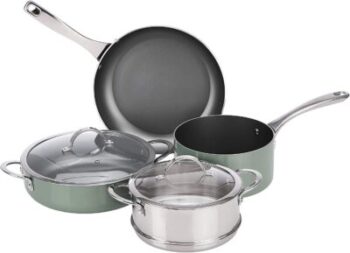
For less than 70 €, it is quite possible to get a quality cookware. This is the case with the Amazon Basics 1116O2OD861. With 6 pieces, this multi-functional model can go in the oven at a maximum temperature of 220 °C.
See priceThe Amazon Basics 1116O2OD861 cookware set consists of a saucepan, skillet, frying pan and steamer. The diameter of each piece remains the same, 20 cm. Heating is fast and even thanks to the special aluminum substrate used in its manufacture. You will save a lot of energy.
The Amazon Basics 1116O2OD861 has several layers of non-adhesive material for greater comfort. Its silicone coating ensures a long life. All handles are made of stainless steel while the lids, also with stainless steel edges, are made with tempered glass.

The ProCook Professional Steel is perfect for heavy use. The set includes 10 pieces, including pots, pans and pans. Their design with 18/10 stainless steel makes them suitable for all fires.
See priceWorthy of a professional, the ProCook Professional Steel lets you have 3 pots, 2 pans, 2 kettles, a stewpot, a steam basket and a sauteuse. It is suitable for all types of fires, including induction. Also, this cookware has been cut to resist to the oven at a maximum temperature of 260 °C. The evaporated water falls instantly into the container during cooking and sprays the food.
Its great practicality comes from its heat-insulated handles and lids. The premium Ultra Plus triple layer coating ensures that your food does not stick to the bottom of each container. The stainless steel guarantees an even distribution of heat. The risk of overheating is reduced to a minimum.

The Stoneline 6588 is made of cast aluminum, giving it the ability to last for years. There is no risk of scratching the bottom of each pan as it has a superior non-stick, scratch-resistant coating.
See priceIf you're looking for a simple, healthy and efficient way to cook, we can't recommend the Stoneline 6588 enough. Equipped with clear glass lids and insulated handles, convenience is at hand. These kitchen utensils are very easy to clean. And because it is so light, it's easy to hold.
The Stoneline 6588 is made of aluminum and is extremely durable, so you can be sure that your meals will taste great. Even if you plan to use no fat, all the vitamins in your ingredients will be perfectly preserved. With a thick 4.5 mm bottom, your dishes won't stick or burn.
Any specific needs?
The best entry-level induction cookware
The best high-end induction cookware
The best cast aluminum induction cookware
Your guide :
Rate this buying guide :By rating this buying guide, you are helping us to reward our best writers. Thank you!
| TOP OF THE LINE | CHEAP | TOP OF THE LINE | EXCELLENT | |

In accordance with our commitment, this buying guide does not contain any sponsored products. |
 9/10 |
 8/10 |
 9/10 |
 8/10 |
| OUR SELECTION |
Tefal Ingenio Preference L9409602
|
Amazon Basics 1116O2OD861
|
ProCook Professional Steel
|
Stoneline 6588
|
|
Composed of 15 pieces, the Tefal Ingenio Preference L9409602 is a cookware with an excellent quality/price ratio. You will discover in the set uncoated pans, frying pans, anti-spatter lids, etc.
|
For less than 70 €, it is quite possible to get a quality cookware. This is the case with the Amazon Basics 1116O2OD861. With 6 pieces, this multi-functional model can go in the oven at a maximum temperature of 220 °C.
|
The ProCook Professional Steel is perfect for heavy use. The set includes 10 pieces, including pots, pans and pans. Their design with 18/10 stainless steel makes them suitable for all fires.
|
The Stoneline 6588 is made of cast aluminum, giving it the ability to last for years. There is no risk of scratching the bottom of each pan as it has a superior non-stick, scratch-resistant coating.
|
|
|
Material
|
18/10 stainless steel
|
Aluminum substrate
|
Stainless steel 18/10
|
Cast aluminum
|
|
Number of parts
|
15
|
6
|
10
|
8
|
|
Specifics
|
Up to 48,000 cycles of use or 12 years
|
Multi-layered, non-adhesive PFOA-free material
|
All fires, oven up to 260°
|
Stoneline non-stick, scratch-resistant coating
|
|
Cleaning
|
|
|
|
|
|
Dimensions
|
37 x 37 x 24 cm
|
56.49 x 38 x 17.98 cm
|
-
|
59 x 37.49 x 21.49 cm
|
Help us improve this table:
Report an error, request the addition of a feature to the table, or suggest another product. Thank you for your kindness!
We spend thousands of hours each year studying the major specialized websites, analyzing products of hundreds of brands and reading user feedback to advise you on the best products.
We are a product review company with a single mission: to simplify your buying decisions. Our research and testing helps millions of people every year find the best products for their personal needs and budget.
To support us you can: use our links to make your purchases (which often earns us a small commission), share our articles on social networks, or recommend our site on your blog. Thanks in advance for your support!
Don't forget that we are talking about cookware that can withstand induction cooking. So that you don't regret your purchase, here are the 5 criteria to take into consideration when choosing.
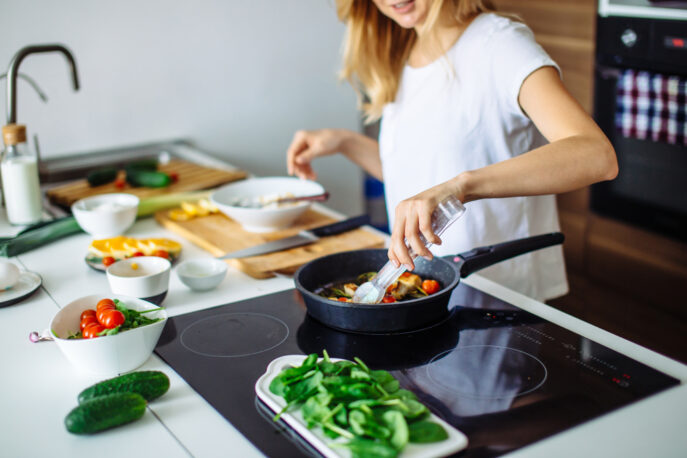
A basic induction cookware set consists of at least 5 elements. This is more than enough for everyday cooking if you are a small family. However, if you have a large family, you should opt for the full range, which can include up to 15 pieces. It is ideal if you are organizing a party or when you have several guests at home.
For
best compatibility with your induction oven, the cookware you'll need to use should be enameled steel or enameled cast iron, multi-layer stainless steel, or stainless steel with inserts or caps. Stainless steel is particularly popular if you want lightness, strength and durability. Cast iron is heavy, but guarantees good heat distribution. So choose the material that best suits your needs.
If
you want to simmer healthy meals that aren't too greasy, go for non-stick cook
ware.
In this regard, ceramic or stone coating is the most common currently in this field. Although these two materials completely coat the inside of some pots and pans, make sure they are still compatible with your induction oven.
If
you have time, go to a store and experiment with your future induction-compatible cookware. See if they're easy to grip and think about how much heavier they'll be once full of food. Make sure they are well balanced. Also check that the handle attachments are tight and secure. Finally, for convenience, bet on a set of cookware that is dishwasher safe.
This piece allows you to keep track of the cooking process. This prevents heat loss and speeds up cooking. Indeed, when cooking is fast, the nutrients in the food are preserved. Note however that glass lids add weight to the cookware, and can also break if they fall off. This could very well happen especially in households with young children. In this case, it is better to use solid metal lids.
Induction cooktops work well with all cookware with a high ferrous metal base. Cast iron pans and all black metal or iron pans will work on an induction cooker. Stainless steel pans are also compatible if their base has a good magnetic quality.
The main materials suitable for an induction oven are iron, stainless steel, cast iron and enamelled steel, while glass, aluminium, ceramic or terracotta and copper will not work.
Stainless steel and cast iron cookware are the most hygienic. Conversely, cookware for induction cookers, which may generate toxic substances, are covered with Teflon or PTFE, and cookware covered with ceramic.
Cookware comes in a variety of materials to ensure safe and hygienic cooking of your food. Here they are with their advantages and disadvantages.
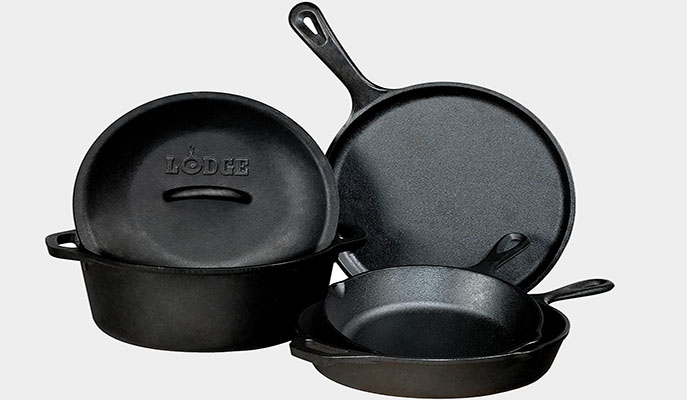
They are excellent alternatives to nonstick cooktops. Lodge, the oldest family-owned cookware manufacturer in the United States, has called these cookware items "natural nonstick."
Cast iron is extremely durable and can be preheated to temperatures that brown meat. It also withstands oven temperatures well above what nonstick pans can handle. Once heated, cast iron cookware will keep your food warm for a long time.
However, some cast iron skillets cook unevenly. In addition, this material is quite hard to clean and impractical for everyday cooking as it is not dishwasher safe and needs to be well cared for (with several coats of oil) to prevent it from rusting especially if it is stored in a humid environment.
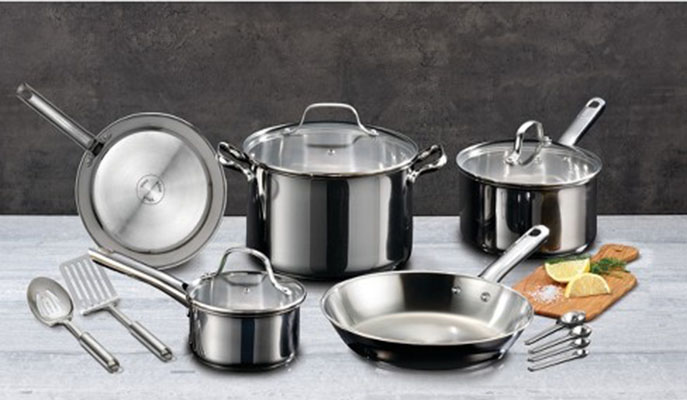
Classic uncoated stainless steel is a good choice for roasting and braising. Often sold in a pack, stainless steel cookware is the most practical and versatile because it can do everything from marinating to making pasta sauces. Durable and easy to maintain, it does not generate reactions once in contact with food and provides quick and even heating.
In addition, most stainless steels are magnetic and compatible with induction cooktops. This set of utensils is dishwasher, oven and broiler safe (depending on the handle material). However, stainless steel is sometimes difficult to clean especially when burned.
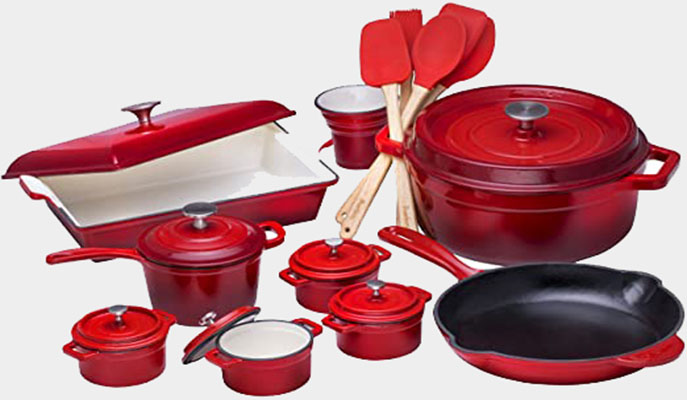
Ideal
for searing, sautéing, browning and frying, these classic and colorful pieces go from the stovetop or oven to your dining table. Enameled cast iron cookware heats slowly and evenly while retaining heat for a long time.
The enamel coating does not react with acidic ingredients. Enameled cast iron cookware is dishwasher safe, corrosion resistant and oven safe up to 500°F. However, enameled cast iron is heavy, and becomes even heavier when filled with food.
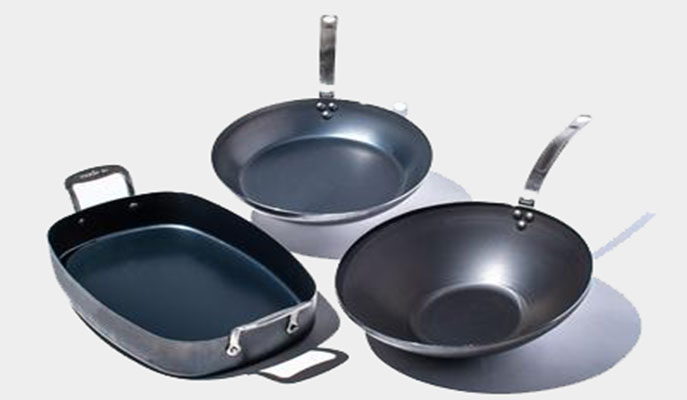
The
term "blue" refers to a special heat treatment process for carbon steels that makes them more resistant to rust and corrosion. These cookware sets are the most coveted in the professional culinary world because they are extremely durable and efficient, and designed for high performance cooking.
Blue carbon steel cookware is ideal for use on any type of cooktop, including induction. This material is also used for woks, omelet pans and pancake pans. It is usually cleaned with paper towels. It must be seasoned (rubbed with several layers of oil) to prevent rusting and is not dishwasher safe. If washing by hand, use only mild soapy water and a soft brush.

Durable nonstick coatings effortlessly release delicate foods, including eggs and pancakes. Nonstick pans are a good choice for low-fat dishes because they require almost no oil. Nonstick cookware is extremely easy to clean as it is dishwasher safe.
Depending on the main material, most pieces are perfect for use on any type of cooktop, including induction. Most pieces are oven safe up to 500° F, but consider the material that makes up the handle.
However, the non-stick pan has a bit of trouble browning food well, and you have to be careful not to scratch the surface material even though most are currently safe to use with metal utensils.
Stainless steel cookware is usually made from a combination of metals, such as iron, carbon and chrome. They may also have small traces of copper, which is another popular cooking material. But the outermost layer must be stainless steel to be able to run on an induction cooker.
Stainless steel cookware is one of the heaviest cookware materials and this weight confirms the authenticity of stainless steel. However, stainless steel generates hot spots, especially in the area in direct contact with the fire. This is both an advantage and a disadvantage for some recipes.
Aluminum cookware is the most common type of cookware used in the commercial kitchen. Aluminum is an excellent conductor of heat, lightweight and inexpensive compared to stainless steel. However, aluminum does not have enough magnetism to activate an induction burner.
In addition, aluminum cookware can give a metallic taste to highly acidic foods like tomato sauce. The same is true for the intense action of a whisk on aluminum, which causes the metal taste to penetrate the food when beating dairy products while preparing an ice cream or soufflé base, for example.
In conclusion, both aluminum and stainless steel cookware are perfect for boiling. The choice between the two will depend mostly on your needs and your cooking habits.
If you do a lot of stir-frying or handle gentle heating, opt for aluminum because the surface of stainless steel lacks non-stick properties. This can cause food to stick to its surface, making cleaning and cooking a bit difficult.
On the other hand, for foods that need a solid browning or crispness, stainless steel cookware can greatly improve the final results.

To save money
A set of cookware is a collection of elements that are intended to cook your food. It includes pots, pans, woks, pans and other utensils. So you have everything you need in one purchase. Plus, buying a set of cookware is cheaper than buying them one by one.
For fast cooking
The cookware collects the heat directly from your induction cooker. So your food cooks quickly. In addition, it easily adapts to the temperature changes you make via the plate. There is no risk of overcooking or undercooking. With good lids, your utensils will perform even better and cook much faster.
For safe cooking
Induction cooktops use a magnetic field produced by the cookware to operate. The plate only heats up when it is in contact with a cooking utensil. As soon as you remove the pan, the plate stops heating. This makes induction cookware safer than other cooking systems.
For cooking healthy foods
If you want to cook foods that are not too fatty, a cookware set can be useful. In fact, you can find models made with non-stick materials. This feature allows you to reduce the amount of oil needed to cook or fry your food. Materials such as cast iron offer good heat distribution for long-lasting cooking. There are also Teflon pans that are the best allies of those who want to lose weight or follow a fat-free diet.
For easy cleaning
Induction cookware is very easy to clean. In fact, to clean an induction pan you only need to use a sponge and dishwashing liquid. They are also dishwasher safe.
In our opinion, the best brands of induction cookware in 2022 are :
Tefal is a French manufacturer of cookware and small appliances belonging to the SEB Group. The brand is currently famous in the UK and throughout Europe. Its products are of high quality and performance.
The brand was launched over 20 years ago and was the first company to sell cookware by direct mail in the UK. Since then it has grown into a multi-channel cookware company with over 50 stores nationwide. Today it is known almost everywhere in Europe.
Today, the STONELINE® cookware brand is the umbrella brand for more than 1,500 different products in a wide variety of shapes and in ever new, contemporary colours. STONELINE® is the most advertised cookware brand in the high quality television sector worldwide and is sold in more than 80 countries around the world.
Circulon is a brand of Meyer Manufacturing Company Limited. Started by Stanley Cheng, Circulon has a solid foundation in sophisticated technology, which demonstrates its quality and reliability. The brand is well known in the field of cookware.
Lagostina is an Italian brand that is becoming known all over the world. It is specialized in the manufacture and sale of kitchen utensils, cutlery and other kitchen utensils. The brand holds an honorable place in this sector and can equalize the products of procook or circulon
The diagram below will help you to get an idea of the typical prices for each price range (entry-level, mid-range and high-end).
However, more expensive does not necessarily mean better.
We therefore advise you to always consult our ranking before deciding, rather than blindly relying on price ranges.
Cleaning
Non-stick cookware is sometimes sensitive to scratching by metal objects. It then requires a special treatment with baking soda for example. To do this, sprinkle baking soda on the bottom of the pan, focusing on the dirtiest areas. Then pour 2 cm of water into the pan. Heat the water until it boils and then let it sit for at least 15 minutes until the mixture cools. Finally, clean with dishwashing liquid then rinse.
Maintenance
Clean
nonstick pots or pans properly before using them. Opt for non-abrasive materials such as wood or plastic when shaking your ingredients and avoid metal even if the manufacturer does not prohibit its use. A small amount of oil is still necessary when using a non-stick pan. Cook your food at a moderate temperature as most enamel coatings cannot withstand too much heat or a sudden change in temperature. Also, do not store food in your non-stick cookware as some acidic ingredients can damage it. Finally, store them neatly by inserting a paper towel between them to prevent each pan from scratching each other when stacked.
Storage
Hanging your pots and pans is a great way to save space while keeping everyday items
within easy reach.
However, if you don't mind having your cookware always visible, store it on open shelves. Open shelves can be sized to fit your kitchen and will allow you to stack your pots and pans neatly. Finally, you can also install hooks under your countertop to hang your pots and pans so they are easily accessible.
Processing of a new stainless steel battery
Wash
your new stainless steel cookware in hot soapy water mixed with ¼ cup of vinegar to remove any manufacturing oils. Rinse thoroughly, then dry with a soft towel. For stainless steel nonstick cookware, condition it before first use with 1 teaspoon (5 ml) full of vegetable oil. Simply apply the oil to the inside of the cookware with a soft cloth. Repeat the conditioning process every 2 to 3 months or when food begins to stick to the pan during cooking.
Seasoning of a cast iron battery
Rub
the utensil thoroughly in hot soapy water. Let dry thoroughly. Spread a thin layer of vegetable oil on the pan or pot. Then place the pan upside down on a central grill at 375°. After that, put aluminum foil on a lower rack to catch the water droplets and then put your cooking utensils in the oven for 1 hour before letting them cool.
The best induction cookware depends on your needs and your budget. Read our buying guide to find out which products are the best.
Most chefs primarily use copper, carbon steel and cast iron. Each of these materials can offer different benefits depending on the type of food or dish you are cooking and even the style of the pan or pot. Keep in mind, however, that copper does not work with induction ovens.
Non-stick pans don't last forever. The rule of thumb is to replace them about every five years. Inspect your pans frequently. When they start to look warped, discolored or scratched, don't use them anymore.
When this happens, tiny particles of the striped coating can seep into your food during cooking or dissolve into the gas as a result of overheating. This is because the toxic fumes released at high temperatures can create serious long-term health problems.
Yes. In addition, induction cookware heats evenly, preventing your food from sticking to the cooking vessels. Using induction cookware on gas or electric stoves will not damage them, nor will it have a negative impact on the food being cooked.
Every month we help more than 1 000 000 people buy better and smarter.
Copyright © 2022 - Made with ♥ by buyingbetter.co.uk
Your reviews and buying guides 0% advertising, 100% independent!